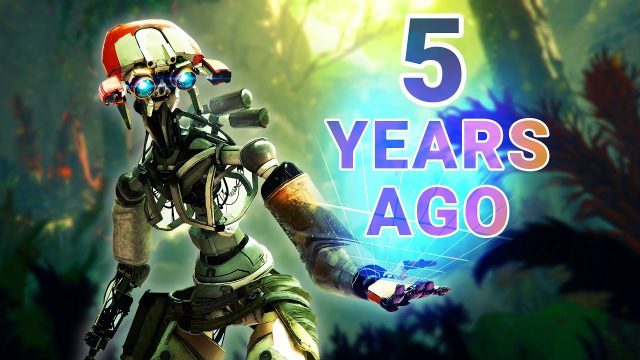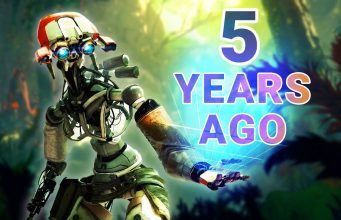

Our series Inside XR Design examines specific examples of great XR design. Today we’re looking at the clever design of Stormland’s weapons, locomotion, and open-world.
Editor’s Note: Now that we’ve rebooted our Inside XR Design series, we’re re-publishing them for those that missed our older entries.
You can find the complete video below, or continue reading for an adapted text version.
Stormland is an open-world action-adventure game with co-op support from Insomniac Games. It’s available on Oculus PC (playable on SteamVR headsets via Revive); check out our full review here.
By the time the studio began development on Stormland, it had already built three VR games prior. That experience shows through clearly in many of Stormland’s cleverly designed systems and interactions.
In this article we’re going to explore the game’s unique take on weapon reloading and inventory management, its use of multi-modal locomotion, and its novel open-world design. Let’s start with weapons.
Weapons
Like many VR games, one of the primary modes of interaction in Stormland is between the player and their weapons. For the most part, this works like you’d expect: you pull your gun out of a holster, you can hold it with one hand or two, and you pull the trigger to fire. But when your gun runs out of ammo, you do something different than we see in most VR games… you rip them in half.
Ripping guns apart gives you both ammo for that weapon type and crafting materials which are used to upgrade your weapons and abilities in the game. In that sense, this gun-ripping pulls double-duty as a way to replenish ammo and collect useful resources after a battle.
Most gun games in VR use magazines to replenish a weapon’s ammo, and while this can certainly work well and feel realistic, it’s also fairly complex and prone to error, especially when the player is under pressure.
Dropping a magazine to the ground in the middle of a firefight and needing to bend over to pick it up might feel reasonable in a slower-paced simulation game, but Stormland aims for a run-and-gun pace, and therefore opted for a reloading interaction that’s visceral, fun, and easy to perform, no matter which weapon the player is using.
This ‘ripping’ interaction, combined with some great visual and sound effects, is honestly fun no matter how many times you do it.
Interestingly, Stormland’s Lead Designer, Mike Daly, told me he wasn’t convinced when one of the game’s designers first pitched the idea for ripping guns apart. The designer worked with a programmer to prototype the idea and eventually sold Mike and the rest of the team on implementing it into the game. They liked it so much that they even decided to use the same interaction for non-gun items like health and energy canisters.
A streamlined approach to weapon reloading isn’t the only thing that Stormland does to make things easier for the player in order to maintain a run-and-gun pace; there’s also a very deliberate convenience added for weapon handling.
If dropping a magazine in the middle of a fight can hurt the pace of gameplay, dropping the gun itself can stop it outright. In Stormland, the designers chose not to punish players for accidentally dropping their gun, by instead having the weapon simply float in place for a few seconds to give the player a chance to grab it again without bending down to pick it up from the floor.
And if they simply leave it there the gun will kindly return to its holster. This is a great way to maintain realistic interactivity with the weapons while avoiding the problem of players losing weapons in the heat of combat or by accidentally not holstering them.
Allowing the weapons to float also has the added benefit of making inventory management easier. If your weapon holsters are already full but you need to shuffle your guns, the floating mechanic works almost like a helpful third-hand to hold onto items for you while you make adjustments.
Multi-modal Locomotion
Locomotion design in VR is complex because of the need to keep players comfortable while still achieving gameplay goals. Being an open-world game, Stormland needed an approach to locomotion that would allow players to move large distances, both horizontally and vertically.
Instead of sticking with just one approach, the game mixes distinct modes of locomotion and encourages players to switch between them on the fly. Stormland uses thumbstick movement when you’re on firm ground, climbing when you need to scale tall structures, and gliding for large scale movement across the map.
Thumbstick movement works pretty much how you’d expect, but climbing and gliding have some smart design details worth talking about.
Climbing in Stormland works very similarly to what you may have seen in other VR games, with the exception that your hand doesn’t need to be directly touching a surface in order to climb. You can actually ‘grab’ the wall from several feet away. This makes it easier to climb quickly by requiring less precision between hand placement and grip timing. It also keeps the player’s face from being right up against the wall, which is more comfortable, and means they don’t need to strain their neck quite as much when looking up for their next hand-hold.
And then there’s Stormland’s gliding locomotion which lets players quickly travel from one end of the map to another. This fast movement seems like it would be a recipe for dizziness, but that doesn’t seem to be the case—and I’ll talk more about why in a moment.
With these three modes of locomotion—thumbstick movement, climbing, and gliding—Stormland does an excellent job of making players feel like they’re free to fluidly move wherever they want and whenever they want, especially because of the way they work in tandem.
Continue on Page 2: VR-centric Open World »
The post This Open World VR Game is Still Ahead of Its Time – Inside XR Design appeared first on Road to VR.
from Road to VR https://ift.tt/jaVW36n
via IFTTT
No comments:
Post a Comment